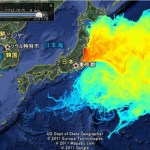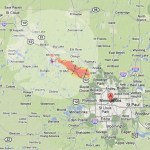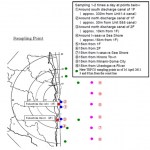Japan Disaster
One of the interesting items we have this week is a study by Greenpeace in which various organisms from the sea near Fukushima were sampled for radioactive isotopes. Let's take a closer look.
The data in the table provided (see the first item in Ana's feed for the link) show the amount of radiation (radioactive decay) by isotope type per kilogram of plant or animal tissue from various samples. On the higher end is a fish with 357 bq/kg of radiation and some seaweed with 190 bk/kg.
What does this mean? Hard to say. I can tell you this: A normal human has about 4,000 or more bq (in total…
For the purposes of discussion in the Japan Disaster threads, I've made a graphic that very roughly approximates the zone of likely future very high rates of cancer if the Fukushima nuclear power plant were located where our (somewhat similar but smaller) plant is located, upwind during the winter of the Twin Cities. The lightened up area (circular) would be the zone in which agriculture would probably cease. Anyone who knows this area knows that the main outputs are electricity and produce!
This is not meant to represent what would happen here ... different plants, different conditions, etc…
It has been Just over six months since a magnitude 9 earthquake and ensuing tsunami struck the Fukushima Daiichi Nuclear Power Plant. In the hours following that incident, nuclear power protagonists filled the blogosphere, the news outlets, and other media with assurances that little could go wrong, that the reactors would be managed, that the disaster would demonstrate, once things had settled down, that nuclear power was, indeed, safe.
One of the first things Ana and I noticed, and we were not alone, is that some of the same stories ... in some cases the same exact wording ... was…
Today all we have for you is Ana's feed, and only the first half. We have both been very busy with distracting things like work and other writing projects and so on. There are interesting things going on at Fukushima and in the Nuclear Power industry in general, as you'll see soon. In the mean time, here's what has been happening:
Fight Over Mining Near Grand Canyon, Other Riders Will Return After Recess -NYT, August 9
-Several lawmakers involved in the congressional debate over uranium mining around the Grand Canyon expect the war of words to reignite as soon as the House returns from…
Things at Fukushima are about as interesting as they've ever been. We want to talk about specific problems at the reactor site, with radioactive material, cooling systems, etc. but first a few words about things happening more broadly, beginning with the largest and work towards the smallest scale. Everything we discuss here is based on the material provided in "Ana's Feed" below. There, you will find detailed notes from media and other sources since our last posting, and links. (See here for all of our postings on Fukushima.)
Globally, it is interesting and disconcerting that Japan…
In the old days this was easy. The power plants were melting down but no one knew what was going on inside them; Water was being poured in and cooking off as steam, and every now and then the way they were getting the water in or the way they were powering the pumps would change, or one of the containment buildings would blow up, or whatever. If you've been reading the last few Fukushima Updates, however, you'll know that things related to the crippled nuclear power plant have gotten more, not less complicated, which at first is counter-intuitive, but on reflection, expected. After all,…
The International Atomic Energy Association issued its last report on Fukushima on June 2nd and appears to not be keeping their web site up to date any more. This is the last time I'll be checking with them unless I hear otherwise. The email scandal reported last time continues "Analysts say the scandal reflects panic in Japan's atomic power industry, long coddled by political, corporate and regulatory interests dubbed the "nuclear village" but now facing growing anti-nuclear sentiment as workers battle to end the Fukushima crisis.? (from Ana's Feed, below). The magnitude of the tsunami…
The Fukushima Update #30 has been translated into German. So if German is your preferred language, you can go read it here. Thanks Frank Braun for the translation.
Perhaps the most interesting single thing on the table in today's update is the revelation that at least one of Fukushima's reactors suffered sufficient damage from the earthquake that hit the region ... prior to the tsunami ... to have likely gone out of control or melted down. This is hard to assess because the tsunami caused so much additional damage as to obscure earlier damage, and because cleanup efforts are not proper forensic methods to reconstruct what happened there, and because we can assume at this point that the untrustworthy TEPCO will cover up whatever it can, and it is in…
Much of the current news is about exposure and fallout.
As a point of information, the Sievert is a unit of "dose equivliant" from exposure to ionizing radiation. It was designed to indicate relative levels of biological effects on living organisms. This measurement technique attempts to take into account the fact that radiation is absorbed differently by different tissues. Usually we speak in terms of humans unless otherwise specified. There are one thousand millisieverts in a sievert (mSv). Zero to 0.25 Sv in a day is considered to have no effect. At up to one Sv people feel sick…
There is an increase in reports of activity of scientists studying the extent and impacts of radiation spilled or otherwise transferred into the ocean from Fukushima. TEPCO, in the meantime, seems to have a need to put a lot more water, possibly decontaminated to some degree, into the sea. Similarly, there is a plan afoot to release previously sequestered air from Reactor 2, with filtering to lower contamination applied to the air before the building's doors are opened. Venting began about four days ago.
Another report has been released confirming that not only did Reactors 1, 2 and 3…
We often drive on a stretch of Minnesota State Route 10 that runs from Elk River to Big Lake and eventually to a point past Saint Cloud that takes about an hour to drive on a normal day, and we see trains. The railroad track runs along this route, and during the hour it takes to drive it, we never fail to see at least one train in operation. Usually there are two or three. Often, maybe every tenth time, one of the southeast bound trains is carrying coal; Dozens and dozens of cars loaded with coal come down this track from somewhere far away, because there is no coal anywhere near here.
The…
In terms of radiation fallout Fukushima is said to be approaching Chernobyl by at least certain measures, and the potential for Fukushima to be worse in terms of total radioactive material released is very real. However, the two disasters really can't be compared sensibly because the circumstances of release, and the potential effects, are very different. It has become increasingly clear that the authorities involved in the initial construction of the plant should have considered the Tsunami risk as a serious factor, and this is not just because the Tsunami actually happened. The…
Even as the situation at the troubled Fukushima Nuclear Reactors ... well, remains troubled ... the post-game analysis of what went wrong and what could have been done better develops. It is becoming clear that the plant had no real plan for the event of a tsunami even though it was built at an elevation within that affected by historically known and documented tsunami waves, and there is post-hoc confusion and denial related to early screw ups in trying to avoid a meltdown in the reactors (which ended up occurring), for instance.
Highly radioactive water continues to leak out of at least…
It is possible that the bottom will fall out of the Fukushima Reactor 4 spent fuel tank. Efforts are being made to shore up the concrete structure. There is no longer any doubt that those mysterious holes hypothesized, seen or not see, in some of the reactor vessels are for real. It is now established that three of the reactors at Fukushima melted down within hours of the earthquake and tsunami. TEPCO is going back and forth on whether or not any of the main reactor machinery was damaged in the quake. It may be that the hydrogen explosions were preventable had standard procedures been…
The worker's death was probably unrelated to the nuclear disaster, but it can't help moral much at the crippled site. Fission and cooling still remain issues at the Fukushima plant. Although fission is not happening to any large degree, or possibly at all, there has been fission more recently than many expected, and there is still concern that the reaction could restart. Various attempts at introducing long term cooling solutions at the site have been less than successful. It is clear that at least two of the reactors will have to be covered by a protective overarching structure.
The…
There is a lot happening in Japan, and the situation at Fukushima remains pretty much out of human control. There is a nuclear incident at a reactor site other than Fukushima. There is still quite a bit of radioactive material leaking into the sea. The radiation levels in the crippled Fukushima plants is still high or even rising. There is information coming out now about radiation levels and exposure that was apparently kept secret earlier for fear of causing panic. And so on. Check out Ana's feed (below) for numerous details and links.
One of the most important things to have come to…
Worker exposure to high levels of nuclera radiation and the distribution of radioactive materials about the landscape and in possibly unexpected places are the stories of the week at Fukushima. Also, officials are wondering, how have the potential effects of a tsunami at Fukushima (and, apparently, it is possible to have a tsunami here) changed given that the reactor is now a series of large pools of highly contaminated water?
The power being supplied to cooling pumps at Units 1,2 and 3 had been switched back to emergency generators because the connections established several days ago need…
The reactors at Fukushima continue to be hotter than "cold shutdown" levels, and at least one reactor (#1) is probably leaking from the core containment vessel. Fission products in high amounts, high pressure, and high temperature indicate that something close to fission is still happening although an apparent lack of large quantities of short lived isotopes may indicate that it has been a while since extensive fission has occurred in the leaking reactor.
There is still concern over possible hydrogen explosions and unexplained "white smoke" continues to rise from several buildings on site…
Tokyo Electric officials have noted that they can not rule out the possibility that fuel rods in the Fukushima reactors have melted, at least to some extent. No one else, as far as I can tell, thinks that fuel rods have not melted. A Question that is more important than that of Tokyo Electric's sudden revelation is, of course, are the fuel rods still melting? The answer is that they may well be.
As of a few hours ago, there is a 20 km offset no-entry zone around the Fukushima Power Plant. The evacuation zone has been reduced from 10 to 8 km. Coagulant continues to be injected into…



